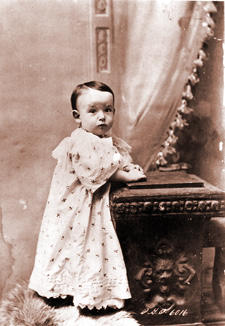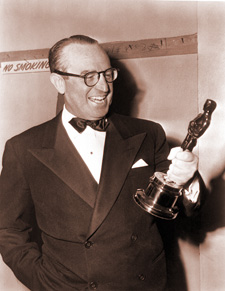 Harold Lloyd was born Burchard, Nebraska on April 20, 1893. He was the second son of James Darsie and Elizabeth Lloyd. His ambition to perform…
Harold Lloyd was born Burchard, Nebraska on April 20, 1893. He was the second son of James Darsie and Elizabeth Lloyd. His ambition to perform…
“… goes back to the first time I can remember knowing what an actor was. I never had any other idea. And when my family moved around, as it did frequently, I began to play in amateur theatricals. When I was only twelve years old, I was playing Little Abe in Tess of the D’Urbervilles.”
Stage roles in school productions led to work in stock theatrical productions. Harold was down to his last nickel in San Diego when the Edison Film Company came to town looking for extras. After shooting his four-second film debut as an Indian in “The Old Monk’s Tale,” Harold set his sights on a career in the movies and moved to Los Angeles.
Harold describes sneaking onto the Universal lot:
“The gatekeeper was a crabby old soul who let me understand that it would be a pleasure to keep me out. As I lurked about I noticed that at noon a crowd of actors and extras drifted out in make-up to eat at a lunch counter across the way, passing the gatekeeper without question each way. The next morning I brought a make-up box. At noon I dodged behind a billboard, made up, mingled with the lunch-counter press and returned with them through the gate without challenge.”
While working on the Universal lot, Harold met Hal Roach, (who would later produce the films of Laurel and Hardy and the Our Gang comedies). When Roach formed his own company, Lloyd joined him. Early comic characters included, “Just Nuts,” “Willie Work,” and “Lonesome Luke,” all characters not very different from Charlie Chaplin’s Little Tramp.
However, it wasn’t until Harold decided to transform his screen character into someone more like himself that his career took off. Harold was the first film comedian to portray a character that looked and acted like someone sitting in the audience – an average guy, the boy-next-door, an everyman. Luke’s ill-fitting tramp outfit was traded in for Harold’s own everyday clothes and a simple pair of horn-rimmed glasses.
With this “glass” character as Harold called it, He could experience the humor in everyday life. And, as an average fellow, Harold’s boy-next-door could have a romance. It was the beginning of romantic comedy in films.
As his new character grew more popular, the one-reel comedies became two-reels. It was during a photo shoot to promote his million-dollar two-reelers that Harold’s promising career came to an abrupt halt.
On a Sunday in August of 1919, Harold posed for a photographer. The set-up called for him to light a cigarette with a prop bomb — the round, black, type you might see in the cartoons. The bomb wasn’t a prop at all; it exploded in his hand. It ripped open the sixteen-foot ceiling and left Harold blind and with most of his right hand missing. Doctors told him he would never see again. His career was over.
But the doctors were wrong. Eventually, his sight did return, the scars healed, and a glove was crafted to hide his handicap from his public. The comedian, known for doing all his own daredevil stunts, felt his audience would be concerned for his safety and not laugh at the movie if they knew about his injury. So he wore the glove in every movie he ever made after the accident.
By 1922, the two reelers had become five reels and Harold Lloyd was making feature length comedies.
If the creation of the “glass” character was a turning point in his career, “Safety Last!” was another. Harold made several successful “thrill” comedies, short films where he found himself out on the ledge of tall building. But the feature length, “Safety Last!” surpassed all the shorter efforts. Harold recounts how he came upon the idea while walking down the street:
“One afternoon in downtown Los Angeles I stopped to watch Bill Strothers, who called himself the Human Spider, scale the sheer walls of a high office building. The higher he climbed the more nervous I grew, until, when he came to a difficult ledge twelve stories up, I had to cut around a corner out of sight of him and peek back to see if he was over the ledge. If it makes me this jumpy, what would it do to a picture audience, I asked myself.”
 “Safety Last!” was the story of an industrious fellow who climbed a skyscraper to win his girl. It’s the ultimate thrill comedy. Harold performed the hair-raising comedic stunt all by himself with only one complete hand. There were no fake backgrounds or computer graphics back in 1923. Strategic camera angles created the dizzy drops. At no time in filming could Harold have fallen more than three stories, but as Harold liked to remind his critics, “Who wants to fall three stories onto a mattress?”
“Safety Last!” was the story of an industrious fellow who climbed a skyscraper to win his girl. It’s the ultimate thrill comedy. Harold performed the hair-raising comedic stunt all by himself with only one complete hand. There were no fake backgrounds or computer graphics back in 1923. Strategic camera angles created the dizzy drops. At no time in filming could Harold have fallen more than three stories, but as Harold liked to remind his critics, “Who wants to fall three stories onto a mattress?”
When the movie opened on April Fool’s Day in 1923 it was a huge success. Harold Lloyd was crowned ‘king of daredevil comedy.’
After filming “Safety Last!” Harold married his leading lady, Mildred Davis, and they raised three children together. Harold constructed an elaborate movie star home in Beverly Hills and called it, Greenacres.
By the mid 1920’s, Harold had left Roach and was producing all the films in which he starred. Of all the silent film comedians, Harold Lloyd was the most profitable. His films out grossed the movies of Charlie Chaplin and Buster Keaton, and he made more films than both of them put together.
With hits like, “The Freshman,” “The Kid Brother,” and “Speedy,” Harold Lloyd was the number one box office star two years in a row. In 1928, Variety proclaimed him the highest paid film star.
Harold was an innovator in the movie business. He pioneered new camera techniques and was one of the first filmmaker to preview his comedies to a test audience, and then re-shoot, re-cut and preview them again. At a time before unions, Harold paid his crew year-round, even when they weren’t shooting a film.
When talking pictures came along, Lloyd was one of the first filmmakers to embrace the new medium. “Welcome Danger” opened in 1929 and was Lloyd’s highest grossing film. Twelve days later the stock market crashed and country changed. Lloyd’s All-American go-getter no longer seemed in fashion to an audience struggling to survive the Depression. His sound films in the 1930s lacked the success of his earlier silent work.
In 1947 Harold made his last movie, “The Sin of Harold Diddlebock.” It was written and directed by Preston Sturges, and produced by Howard Hughes. As an actor-for-hire, Harold no longer had total control as he had back in the 1920’s and didn’t find the experience very rewarding. He had made 200 films since his four-second debut in 1913, and it was time to move on.
In 1949, Harold’s face graced the cover of TIME Magazine as the Imperial Potentate of the Ancient Arabic Order of the Nobles of the Mystic Shrine, their highest-ranking position. He devoted an entire year to visiting 130 temples across the country giving speeches for over 700,000 Shriners. The last twenty years of his life he worked tirelessly for the twenty-two Shriner Hospitals for Children and in the 1960’s, he was named President and Chairman of the Board.
In addition to the Shrine, Harold had his hobbies. Whatever he put his mind to, he mastered: chess, bowling, microscopy, painting — Harold became a color expert and developed a color palette for artists. In the late 40s, Harold developed an interest in 3-D photography and traveled the world taking pictures. In the last twenty years of his life he amassed close to 300,000 stereo slides.
 Throughout his long career, Harold received many tributes. He was the fifth film star to immortalize his hand and footprints in the pavement outside Grauman’s Chinese Theatre in Hollywood, and he has two stars on the “Walk of Fame.” The George Eastman House honored him twice for his work in movies, and in 1953, Harold received an honorary Academy Award for being a “Master Comedian and Good Citizen.” Over twenty years after his death, his bespectacled face appeared on a U.S postage stamp.
Throughout his long career, Harold received many tributes. He was the fifth film star to immortalize his hand and footprints in the pavement outside Grauman’s Chinese Theatre in Hollywood, and he has two stars on the “Walk of Fame.” The George Eastman House honored him twice for his work in movies, and in 1953, Harold received an honorary Academy Award for being a “Master Comedian and Good Citizen.” Over twenty years after his death, his bespectacled face appeared on a U.S postage stamp.
Harold Lloyd died in 1971 at his home in Beverly Hills, CA at the age of seventy-seven. After his death, his magnificent estate was run as a museum but the property was eventually auctioned off and subdivided. The house and six acres still remain. In 1984, Greenacres was placed on the National Register of Historic Places.
It’s not surprising that today the films of Harold Lloyd are being rediscovered. As Harold stated several years before he died,
“It has been amazing to me that these comedies can still strike a responsive note of laughter with audiences of all ages and in all parts of the world. Laughter is the universal language. It establishes a common identity among people—regardless of other differences. It is the sweetest sound in the whole world.”
